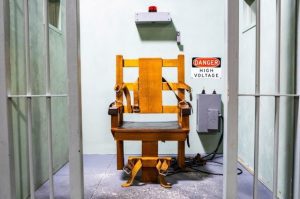[ad_1]
Theoretically, death row inmates should have the toughest time breaking out of prison. They aren’t in minimum security prisons, after all. And they aren’t allowed to do work release programs, weekend furloughs, or daytime labor gigs in the community. In most states, convicted murderers spend all day locked up in tiny single cells. With maybe an hour here or there for exercise, the rest of their time is spent in solitary confinement far away from the general prison population and light years away from the public. Or at least it should be.
So how did it all go wrong on May 31, 1984, when not one or two but six death row inmates escaped from Virginia’s Mecklenburg Correctional Center? The shocking and brazen prison break is still a fascinating story for prison officials and crime reporters to study four decades later. It marks both a significant breakdown in prison policy as well as a cautionary tale about what can happen when sadistic, violent individuals get together and plot for a purpose.
So today, you’ll learn all about the Briley Brothers, the fake bomb threat, and the rest of the story behind the Mecklenburg Correctional Center prison break of 1984. Never before or since has a jailbreak been so crazy—or so successful. It seems like it should be a blockbuster movie script or a wild television thriller, but it’s not! This is the true story of one of the wildest events in the history of American prisons.
Related: 10 Serial Killers Who Were Shockingly Released From Prison Early
10 A Prison Unlike Any Other…
The Mecklenburg Correctional Center was supposed to be escape-proof. When it was opened in the spring of 1977, Virginia Governor Mills E. Godwin showed up to the ceremony. He touted the prison as being a state-of-the-art facility. As he cut the ribbon to open the prison, he boasted about the millions of dollars that went into constructing it. Criminal justice was coming to Virginia, Godwin claimed, and it was going to bring the state quickly and completely into the modern age.
Hundreds of people were on hand for Godwin’s fiery opening day speech. Reporters documented his words, and flashbulbs went off as he boasted about the importance of being tough on crime. The prison was to represent “a firm and lasting and unbreakable connection between crime and punishment,” Godwin boomed during the event.
Virginia residents were excited about the historic facility as a deterrent for crime. But Godwin had no idea what would happen just seven years after his bombastic speech about building the perfect place for incarceration. In time, the Mecklenburg Correctional Center was to be the site of the largest death row prison break in American history.[1]
9 Until the Briley Brothers Show Up
Just a few years after Mecklenburg was first built and opened, the Briley brothers went on a rampage around Richmond. Over a seven-month period in 1979, Linwood, Anthony, and James Briley had their way with innocent civilians all around the Virginia town. They committed sadistic murders, rapes, and robberies.
Cops always seemed to be one step behind them as the Briley boys ruined innocent lives all over town. Finally, though, they were caught. As their case wound through court, it quickly became clear Linwood and James were destined for death row. By 1984, that’s exactly where they were. But they didn’t just sit in jail and wait to die. Instead, they worked their contacts on the inside by shrewdly making friends with guards.
As soon as Linwood and James got to Mecklenburg, they began working the system. They were smart and cunning, and they knew how to influence people. They got on the guards’ good sides and made friends with other inmates. Immediately, the guards liked that they were seemingly helpful and easygoing. Soon, they gained the trust of several key guards on death row.
But what the guards didn’t know was that the Briley brothers were always watching. They had figured out the prison’s schedule and the guards’ daily activities. They had committed to memory several key procedural weaknesses exhibited within death row. And worst of all, they were slowly amassing an arsenal of crude, homemade weapons. Soon, these items would be a critical part of their shocking escape plan.[2]
8 Bathrooms, Books, and Prison Breaks

After a few months of this, the Briley brothers’ plan started to become clear to other death row inmates. A few of them were worried about being harmed by the brothers or other inmates during the coming escape attempt. Others were concerned that the whole plan would go awry and make life more difficult in the prison. So they went to the guards with their concerns.
To prison officials’ credit, they reacted quickly and decisively—at first. Mecklenburg’s warden issued a prison-wide lockdown beginning in April 1984. It extended into May, and for a bit, it kept the Briley brothers at bay. But by the end of May, human rights activists and Virginia prison bureaucrats alike were calling for the end of the lockdown. So the warden lifted it. But just a few days later, all hell would break loose.
On the night of May 31, the plan was in place, and the break was initiated. It started when inmate Earl Clanton Jr. snuck out of line on his way back to the cell. He locked himself in a bathroom without guards realizing what was going on. Then, around 9 pm, James Briley asked a guard in the control booth to get him a book that had been locked in the day room. The guard agreed and went to open the door.
When he did so, Clanton jumped out of the bathroom and took the guard hostage. Within seconds, he had access to the control room. Moments after that, Clanton opened all the doors in the unit. The rest of the inmates overpowered other guards, tied them up, and forced them into cells. Suddenly, Mecklenburg Correctional Center had a major problem on its hands.[3]
7 The Prisoners Call in a Bomb Threat
As more guards rushed to the death row unit, the Briley brothers and other inmates attacked them too. When one lieutenant finally entered the unit, the Brileys held him hostage with one of the makeshift knives pressed to his throat. They forced him to get on the radio and call in a false report to the other parts of the prison.
The message went like this: The inmates had assembled a bomb on the unit, and the lieutenant had to get it out of the prison before it detonated. As he was ordered, the lieutenant asked guards on the other side of the radio call to deliver a prison van to the back of the death row unit. The plan, as it went out over the radio, was for the lieutenant to put the bomb in the van and drive it far away from Governor Godwin’s expensive, new prison.
Of course, there was no bomb. But amazingly, the ploy worked. As prison officials rushed to get a van to the door at the back of death row, the Brileys and other inmates acted on the next phase. They raided a storage closet and found exactly what they were looking for: riot gear. They put on guard uniforms they had taken off their captives and put the riot gear over it.
Then, the six inmates put on riot masks and helmets to completely conceal their identity. When their disguise was complete, they took a stretcher and a blanket and went to look for a bomb. They found one in the form of an old television. They put it on the stretcher, covered it with the blanket, and added a fire extinguisher and hose to the mix to complete the “bomb.” Now, they were ready to rush out to the van and escape the prison grounds.[4]
6 The Bomb Plot Actually Worked!

When the prison van was put in place, six men in guard uniforms and riot gear came outside while pushing the “bomb” on the stretcher. The men were Linwood and James Briley, along with Earl Clanton Jr., Derick Peterson, Lem Tuggle Jr., and Willie Leroy Jones—and all six were death row inmates. Of course, other guards around the facility didn’t know that. Mecklenburg’s warden and officials thought these were the guards who first reported to the prison uprising now trying to dispose of a bomb. The inmates moved quickly, rushing the stretcher into the back of the van. Then, all six climbed in and started it up to drive away.
There was just one more problem: They needed to get off prison grounds before they were free. To do that, two different sets of gates needed to be opened. And there was one guard in a tower with access to those gates. She was the last person who stood between the Briley brothers and freedom.
For a moment, she was hesitant to let the van pass through. She had seen the “bomb” loaded into it moments before, but she was skeptical about the situation. After a few tense moments, though, she opened the gates. The Briley brothers and their four accomplices gunned the van engine and drove off into the night. And with that, six death row inmates were now on the loose.[5]
5 The Cons Disappear into the Night
Before the convicts escaped, they had raided the guards’ pockets and personal items. In that looting, they found almost $800 in cash. They also came away with cartons of cigarettes and several more changes of clothing. So in their minds, they were well-outfitted for a rushed trip up north to Canada.
Their feeling on that border move was simple: The Canadian government has long been opposed to capital punishment. And while the men may have eventually gotten caught north of the border, the Canadians wouldn’t extradite anyone who would be sent back to a country to be executed. So Canada was the game plan. But first, they had to split up.
With the bomb threat ploy and the disguises, the six men had gotten a head start. The van helped them get away much more quickly than they would have on foot. And the fact that the escape occurred at night allowed them to run under the cover of darkness for a while. Those hours proved to be a crucial head start.
Mecklenburg officials alerted local law enforcement agencies as quickly as they could that night. Sheriffs, police officers, and SWAT team members around Virginia were put on high alert. But full-scale search parties were hard to come by until sunrise. By then, the Brileys and their accomplices had almost an eight-hour drop on the authorities. And every minute only made it more difficult to find them.[6]
4 Police Start Rounding ‘Em Up
Thankfully, Virginia cops acted quickly and got right on the van’s trail. The next day, two of the inmates were apprehended by police in the small town of Warrenton. They were Earl Clanton Jr. and Derick Peterson, and they hadn’t managed to get very far at all after escaping.
Clanton was spotted at a local laundromat in the city. An eagle-eyed resident called in his description, and police came rushing. Peterson was handcuffed as he walked out of a convenience store in town hours later. Cops in Warrenton also found the escape van itself. It was empty and ran aground on the side of the road—so it was immediately clear that the other four inmates had ditched it to use other means of escape.
Two other inmates nearly made it all the way to Canada, though. Lem Tuggle Jr. was arrested days after the escape in the city of Woodford, Vermont. He was only about 250 miles (402 kilometers) from the Canadian border at the time. Incredibly, he had been dumb enough to rob a convenience store in that town at knifepoint. Workers called the cops, who showed up quickly and gave chase. They caught him after a brief struggle.
As for Jones, he made it even closer to Canada before being caught—just about 100 miles (161 kilometers) from the border. But he, too, was tracked down days after the escape. All four men were arrested and returned to prison. There, they were quickly put under lockdown by officials worried about future problems and bad publicity.[7]
3 The Briley Brothers Get Caught Last…
But while the other four men were caught in pretty short order, the Briley brothers proved a bit more elusive. They stuck together after the prison break and headed north for Philadelphia. Days turned into weeks, and police had no solid leads on where they could be. Despite the brothers having made connections with former associates in Philly, nobody ratted them out to cops.
Nobody, that is, until Tuggle tried to strike a deal with prison officials. He told cops the brothers had been dropped off outside Philadelphia and were likely still in that area. The FBI looked into the brothers’ distant family members in Philadelphia and learned of their whereabouts. From there, they quietly descended on the area and set up observation points around the neighborhood.
The FBI knew they were hot on the trail when they found a pair of prison guard uniforms hanging carelessly from some tree branches. By then, cops were certain they were on the right track. The FBI tapped the phone lines of the Briley brothers’ various acquaintances up and down the east coast. One day, a pal in New York got a call from a garage in Philadelphia.
The authorities traced the call and staked out the garage belonging to the brothers’ uncle. An undercover officer observed the place for hours and saw two men who looked like James and Linwood walking around the property. Within hours, dozens of FBI agents swarmed the place. The Briley brothers really were there—and they had been barbecuing chicken in the alley when cops came calling. The pair was arrested again without incident. They had been on the run for nearly three full weeks.[8]
2 But Get Executed First

By this point, the feds were fed up with Linwood and James Briley. Virginia prison officials didn’t care much for them, either. After all, their prison escape had made national headlines for three weeks. The whole time, the Briley brothers’ brazen move to thumb their nose at the law made Governor Godwin’s state-of-the-art prison and its officials look like amateurs.
Plus, Linwood and James had already both been convicted of unspeakable horrors that got them on death row in the first place. So when they were recaptured, law enforcement officers, prison officials, and the public all collectively wanted to see justice served. For these deadly death row escapees, that meant execution by the state.
Linwood was the first Briley brother to die. He appealed his initial death sentence all the way to the Supreme Court, but they refused to hear it. So on October 12, 1984, he was executed by the state of Virginia. He maintained his innocence of all crimes right up until the moment of his death. Six months later, on April 18, 1985, James was also executed by the state.
His death didn’t come without its own drama, though. On the day of James’s scheduled execution, a riot broke out on death row. Nine prison guards were injured in the incident, and a considerable amount of damage was done to the unit. However, it didn’t change the outcome of the case, and James Briley was executed that evening.
The third brother, Anthony Briley, had previously been sentenced to hundreds of years in prison for the trio’s past Richmond crimes. He was not involved in the prison break and was not executed.[9]
1 And Then, It Was All Over
Three years after James Briley died, Earl Clanton became the next escapee to be executed. He was executed by the state of Virginia in April 1988 after exhausting all of his legal appeals. Unlike the Brileys, he actually expressed remorse for the murder that landed him in jail. But it wasn’t enough to save him.
Similarly, Derick Peterson appeared to show some remorse for his past crimes. But appeals courts weren’t swayed by his sob story—especially considering how he’d been involved so intimately in the escape. So Virginia sent him to his death in August of 1991. His electrocution had to be repeated after it didn’t fully work the first time. In that final moment, Peterson was again an embarrassment to Virginia prison officials. But with his death, four of the six prison escapees were now gone.
Willie Leroy Jones didn’t have to wait much longer than Peterson for his death. Jones, who had murdered an elderly couple in a horrible crime that first put him in prison, went to the electric chair in September 1992. His lawyers pushed an appeal all the way to then-Virginia Governor L. Douglas Wilder before the fateful night. But in the 11th hour, Wilder turned down Jones’s appeal.
Four years later, Lem Tuggle became the final prison breaker to die. He opted to die by lethal injection in December 1996. As he was sent to the chair, he had two final words for the onlookers in the prison: “Merry Christmas!” Moments later, he was dead—with no chance to wish everyone a Happy New Year.[10]
[ad_2]
Source link

